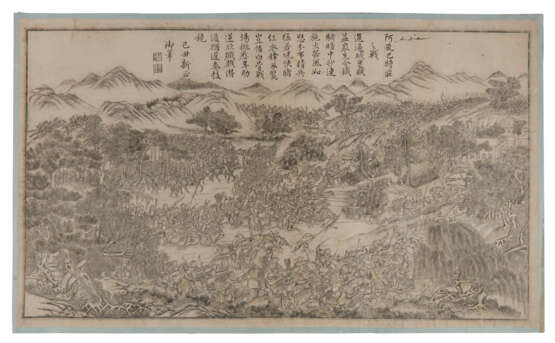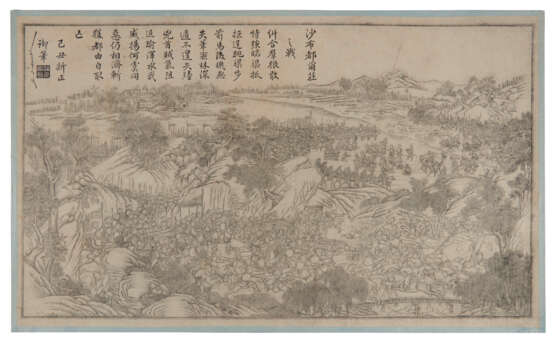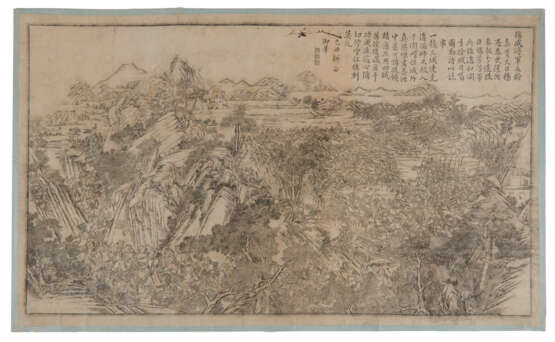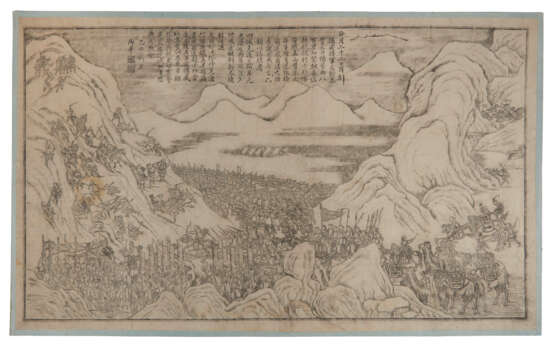ID 993154
Lot 211 | EMPEROR DAOGUANG (1782-1850, r.1820–1850) – HE SHIKUI (fl.1829), artist
Estimate value
£ 20 000 – 30 000
[Pingding Huijiang Desheng Tu (Images of the reconquest of East Turkestan). Beijing: 1829.
An exceptionally rare set of eight engravings from the suite commissioned by Emperor Daoguang (1782-1850, r.1820–1850) to commemorate his victory of the second campaign in Kashgar against the rebel Jahangir Khoja during the years 1826-1835. This was in the tradition initiated by the Qianlong Emperor (1711-1799, r. 1735-1796) in the second half of the 18th century to commemorate military campaigns by commissioning 'battle prints.' Through the Jesuit painters present in the imperial court during the 18th century, the Qianlong Emperor had been exposed to, and impressed by, engravings of battle scenes by such western artists as Georg Philipp Rugendas the Elder (1666-1742). To commemorate his military exploits of his Ten Great Campaigns, the Qianlong Emperor commissioned wall paintings by the Jesuit artists to decorate his palace in Beijing. Smaller engraved versions of these were then commissioned, with the prints being engraved and printed in Paris in 1767-1774. When these engravings reached Beijing, Chinese artists and engravers then made Chinese versions of these prints, to which victory poems in the Emperor's own calligraphic hand were added to the top of each print. Thus a new style of western-influenced, but wholly Chinese, artform was introduced.
In 1826, Jahangir, the exiled heir to the Khojas, rose up against the Qing Empire, and attacked Xinjiang from Kokand. By the end of 1826, the former Qing cities of Kashgar, Yarkand, Khotan, and Yangihissar had all fallen to the rebels. The Daoguang Emperor responded in 1827 by sending General Changling and 22,000 troops to reconquer the city of Kashgar and to capture Jahangir. Jahangir escaped but was later betrayed and sent to Beijing, where the Daoguang Eemperor had him ritually presented at the Imperial Ancestral temple before he was hacked to death.
The complete set of engravings is titled:
1. Battle at the Hobasi River (not present here)
2. Battle at the Korping (not present here)
3. Battle at Yangi-arbat
4. Battle at Sabdul-zhuang
5. Battle at Awabat-zhuang
6. Recapture of Kashgar and Capture of the Rebel Chief
7. Recapture of Khotan and capture of rebel chief, Garla
8. Capture of the Rebel Chief, Jahangir, at the Hartagai Mountain
9. Presentation of the prisoners at the Wumen gate
10. Banquet of the victory at Zheng Da Guang Ming Palace
The present series was entirely produced in China. Only sixty sets were printed for presentation to princes and high officials. As a result, the 1830 engravings are considerably scarcer than the earlier Qianlong editions.
Very rare: Von Walter Fuchs in his essay ‘Die Entwürfe der Schlachtenkupfer der Kienlung-und Taokuang-Ziet’ (The Drafts of the Battle Engravings of the Qianlong and Daoguang period), Monumenta Serica, vol. 9, 1944, pp. 101–122, mentions four existing sets of these Daoguang engravings (p. 19, footnote 83): one in the collection of Luo Zhenyu, one in the Dairen Library, one in the Peking jimbun kagaku kenkyûsho, and one in his own collection. See also Harmut Walravens, ‘Die Schlachtenbilder der Qianlong-und Daoguang-Zeit’ in China Illustrata: Das Europäsche Chinaverständnis im Spiegel des 16 bis 18 Jahrhunderts, Weinheim, 1987, pp. 36–56, discussing the Imperial Battle paintings of Qianlong and Daoguang. A copy of the complete series, mounted in a horizontal roll, sold at Sotheby’s New York, 21st September 2006, lot 10.
8 (of 10) engravings (each 555 x 900mm). Some inscribed with Imperial poems, accompanied by the Emperor’s seal mark, and dated the first month of 1829 (numerous worm traces with engraved surface skilfully reinstated in facsimile, some spotting, without the plates of the first ‘Battle at River Honbasi’ and the second ‘Battle at Korping’ in the series).
| Artist: | Emperor Daoguang (1782 - 1850) |
|---|---|
| Place of origin: | China, Eastern Asia, Asia |
| Category: | Art prints |
| Artist: | Emperor Daoguang (1782 - 1850) |
|---|---|
| Place of origin: | China, Eastern Asia, Asia |
| Category: | Art prints |
| Address of auction |
CHRISTIE'S 8 King Street, St. James's SW1Y 6QT London United Kingdom | |
|---|---|---|
| Preview |
| |
| Phone | +44 (0)20 7839 9060 | |
| Buyer Premium | see on Website | |
| Conditions of purchase | Conditions of purchase |








